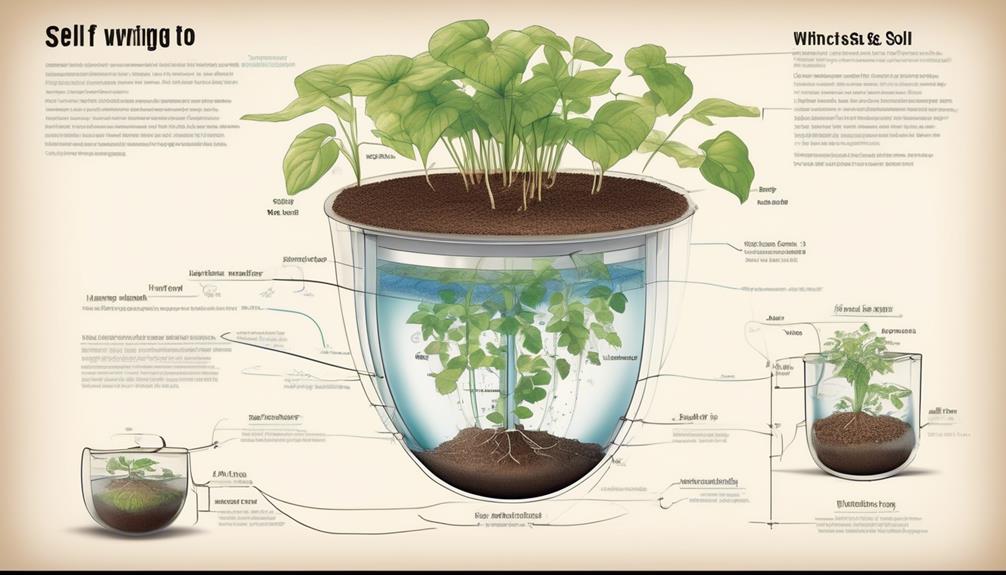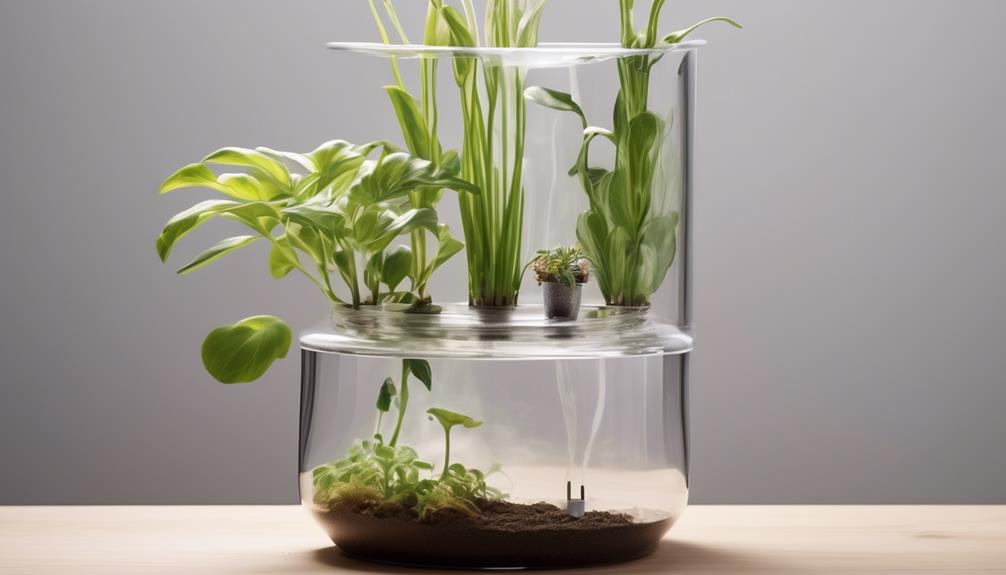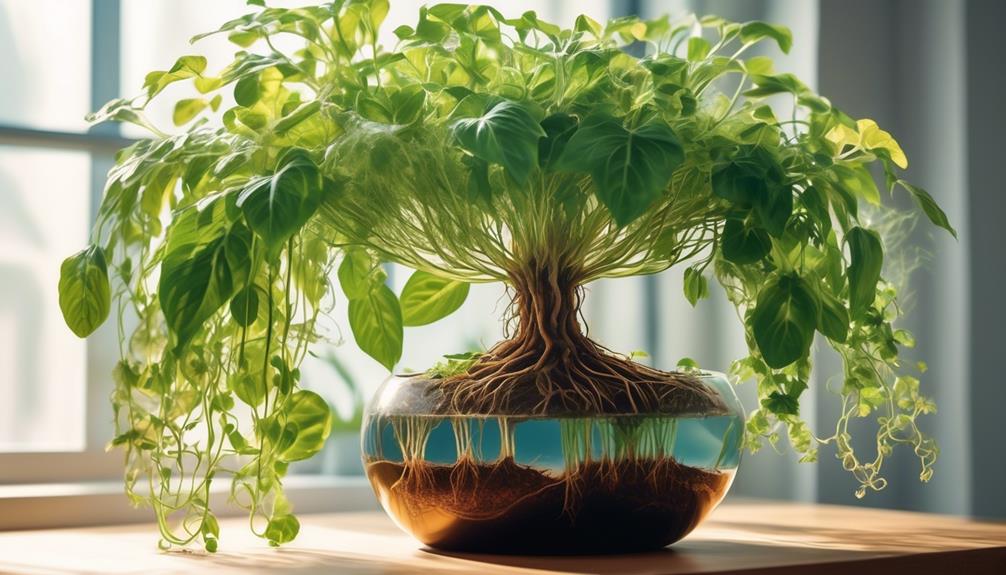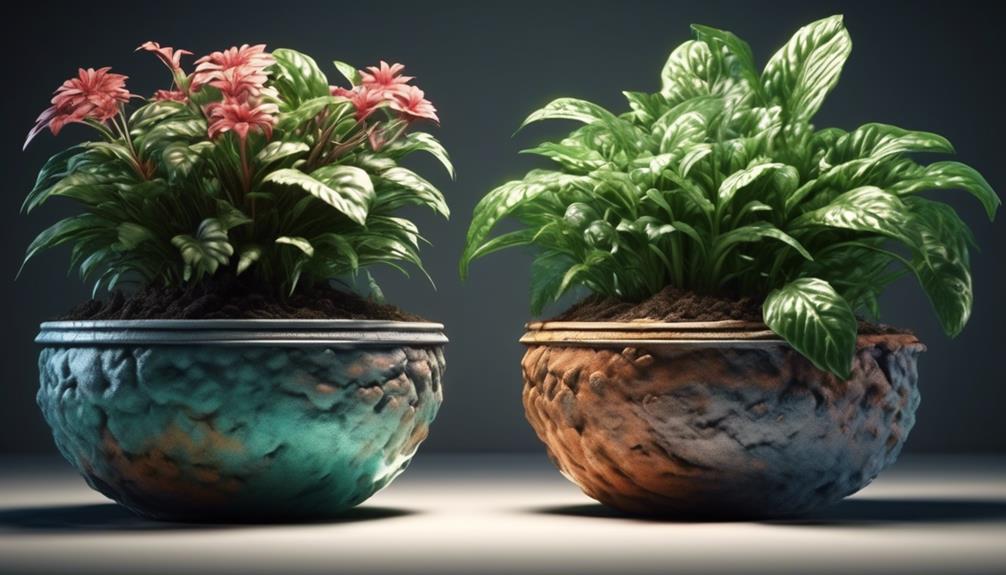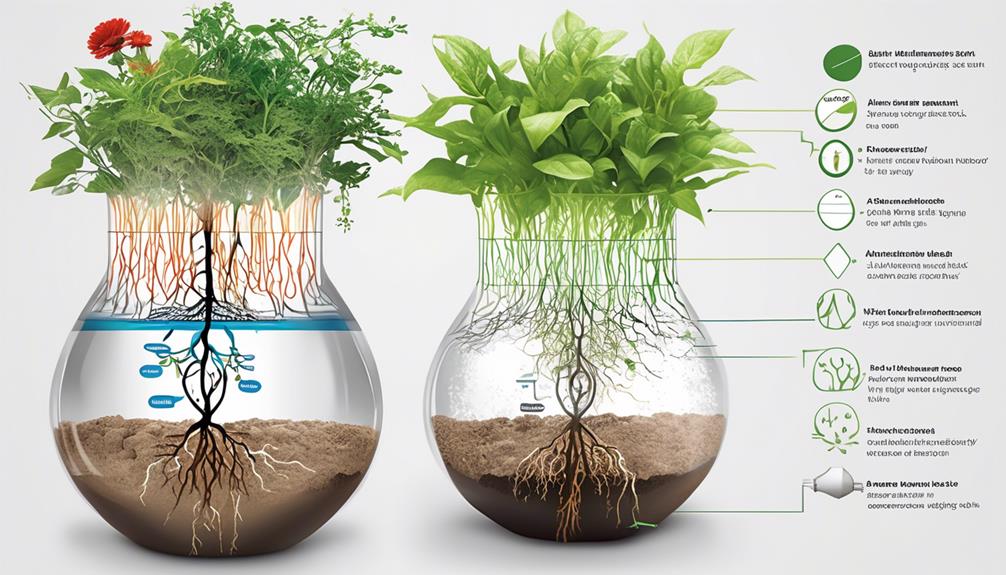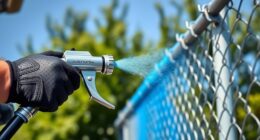Have you ever thought about how self-watering planters work? It almost seems like magic, doesn’t it? A planter that takes care of watering your plants all on its own.
But as I delved into the science behind it, I was fascinated to uncover the intricate mechanisms at play. From capillary action to soil moisture regulation, there are a number of factors at work that ensure your plants receive just the right amount of water.
But how exactly does it all come together? I was curious to find out, and as I began to unravel the mysteries behind these innovative pots, I realized that there's much more to it than meets the eye.
Key Takeaways
- Self-watering pots utilize a reservoir system to supply water to plants based on their needs.
- The capillary action mechanism ensures that water moves upward through the soil, keeping it consistently moist.
- The water reservoir function serves as the primary source for the capillary action mechanism and maintains optimal moisture levels for plant growth.
- The soil moisture regulation and wicking process are crucial for maintaining optimal soil moisture levels and preventing overwatering or underwatering.
Self-Watering Pot Basics
Self-watering pots automatically supply water to plants based on their needs, making them a practical and efficient solution for maintaining healthy and thriving indoor or outdoor gardens. These innovative containers work by utilizing a reservoir system, which allows for consistent moisture levels in the soil. The watering frequency is controlled by the plant's own uptake of water, ensuring that it receives just the right amount, reducing the risk of over or under-watering.
In addition to managing watering frequency, self-watering pots also play a crucial role in nutrient delivery. The water in the reservoir is often mixed with fertilizer or plant food, ensuring that essential nutrients are consistently available to the plant's roots. This controlled delivery system helps to optimize plant health and growth, as the roots can access water and nutrients as needed.
Understanding the basics of self-watering pots is essential for any gardener seeking to create an environment where plants can thrive with minimal maintenance. By providing a steady supply of water and nutrients, these pots offer a practical and efficient solution for maintaining healthy and vibrant plant life.
Capillary Action Mechanism
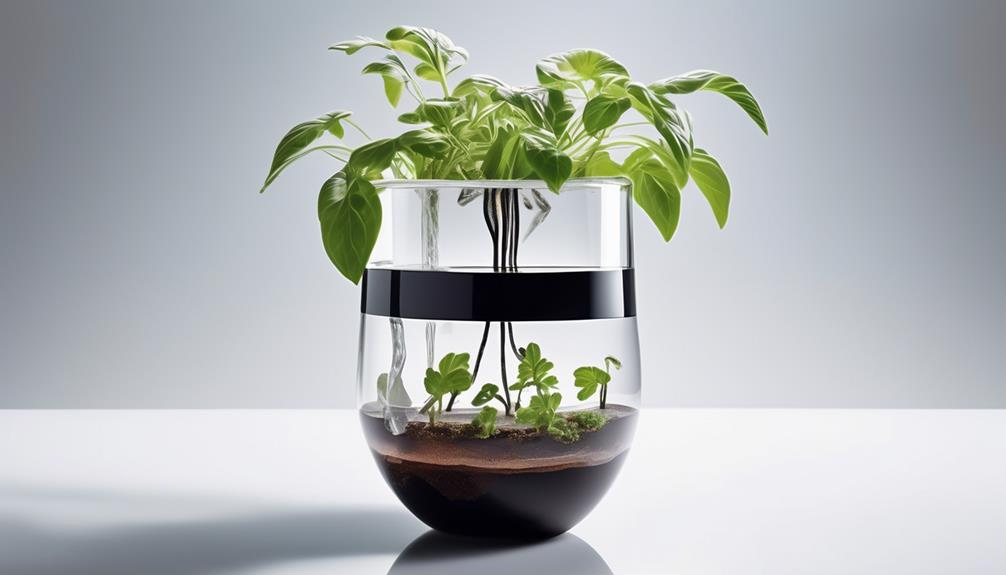
The capillary action mechanism, integral to the functionality of self-watering pots, allows for the efficient transport of water from the reservoir to the soil, ensuring consistent moisture levels for optimal plant health.
Capillary action explanation: This mechanism relies on the cohesive and adhesive properties of water. The water, drawn by the porous material of the pot, moves upward through tiny spaces in the soil due to capillary forces, providing water to the plant's roots. This process ensures that the soil stays consistently moist, preventing overwatering or underwatering, which are common issues in traditional pots.
Plant health: By maintaining the soil's moisture at an optimal level, the capillary action mechanism promotes healthier root systems and overall plant growth.
Water absorption, soil hydration: As the soil dries out, the capillary action continuously pulls water from the reservoir into the soil, allowing the plant to absorb water as needed. This regulated water absorption ensures that the plant's hydration needs are consistently met, contributing to its overall well-being and vitality.
Water Reservoir Function
Now, let's explore the crucial role of the water reservoir in self-watering plant pots.
The water reservoir serves as the primary source for the capillary action mechanism, facilitating the efficient absorption of water by the soil.
Furthermore, it enables gravity to release water to the soil as needed, ensuring optimal moisture levels for the plant's growth and health.
Subheading 1: Water Absorption Process
Using a capillary action, the soil in the pot draws water from the reservoir, allowing the plant to absorb moisture as needed. This process ensures that the soil moisture remains at an optimal level for sustained plant growth.
- Capillary Action: The soil, through capillary action, pulls water from the reservoir into the root zone, ensuring a steady supply of moisture for the plant.
- Moisture Regulation: As the plant absorbs water from the soil, the moisture level in the reservoir decreases. Conversely, when the reservoir is filled, excess water is prevented from reaching the plant's roots, thus avoiding waterlogging.
- Optimal Growth: This continuous cycle of water absorption and regulation ensures that the plant receives just the right amount of water, promoting healthy growth and minimizing the risk of overwatering or underwatering.
Subheading 2: Gravity Water Release
Drawing from the capillary action discussed previously, the gravity water release from the reservoir facilitates a controlled and efficient supply of moisture to the plant's root zone.
As the soil dries out, the plant roots seek moisture, drawing water up from the reservoir through capillary action. However, once the soil reaches an optimal moisture level, the excess water is retained in the reservoir.
When the soil moisture decreases, gravity pulls the water from the reservoir into the soil, ensuring a constant supply of water to the plant.
This gravity-driven process prevents overwatering by releasing water only when needed, thereby maintaining an ideal moisture balance for the plant.
This mechanism optimizes water usage and fosters healthy plant growth, making it an effective and sustainable solution for plant care.
Subheading 3: Soil Moisture Regulation
The water reservoir function in self-watering plant pots maintains optimal soil moisture levels by providing a controlled and efficient supply of water to the plant's root zone. This soil moisture management is essential for proper plant hydration techniques and overall plant health.
The water reservoir function operates through a combination of capillary action, evaporation, and root uptake, ensuring that the plant receives water as needed.
Here's how it works:
- Capillary Action: The soil draws water from the reservoir through capillary action, ensuring that the entire root zone remains consistently moist.
- Evaporation: Excess water in the reservoir evaporates, preventing waterlogging and maintaining a healthy balance of moisture in the soil.
- Root Uptake: The plant's roots naturally absorb water from the moist soil, regulating their hydration levels.
This integrated approach effectively sustains the plant's optimal soil moisture, promoting healthy growth and vitality.
Soil Moisture Regulation
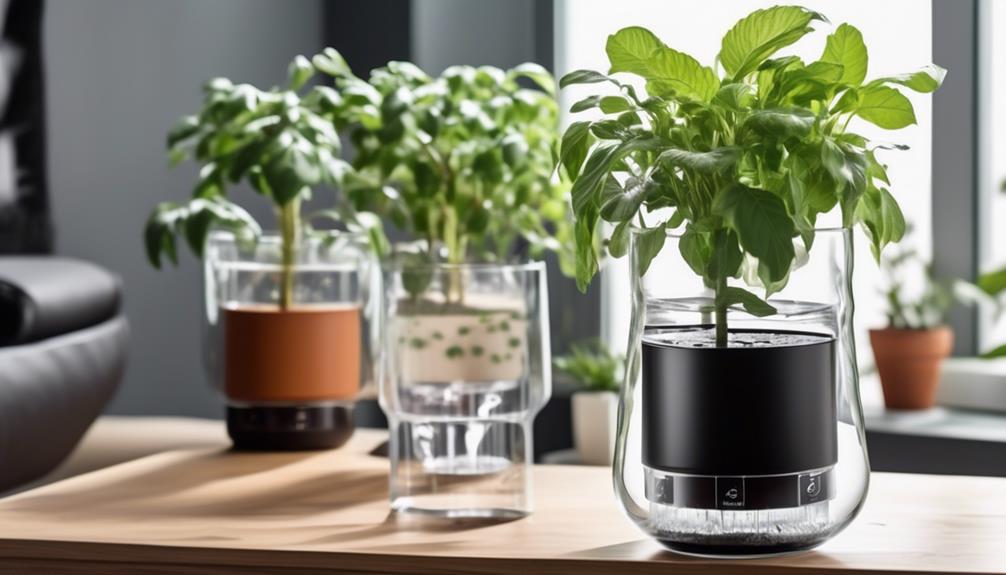
To maintain optimal soil moisture levels in self-watering plant pots, it's crucial to monitor and adjust the watering frequency based on the specific needs of the plants being grown. Soil moisture regulation is essential for plant hydration and overall health. The self-watering mechanism in these pots helps in maintaining consistent moisture levels, but understanding the moisture requirements of different plants is crucial for successful growth.
The key to effective soil moisture regulation lies in understanding the water needs of the plants and the moisture retention properties of the soil. Factors such as the type of plant, its growth stage, the pot size, and the environmental conditions all play a role in determining the watering frequency. For example, plants in a sunny location will generally require more frequent watering compared to those in a shaded area.
Regularly monitoring the soil moisture levels using a moisture meter or by simply feeling the soil can help in determining the watering needs of the plants. Adjusting the watering frequency based on the observed soil moisture levels is fundamental in achieving the optimal soil moisture for plant growth and health.
Wicking Process Explained
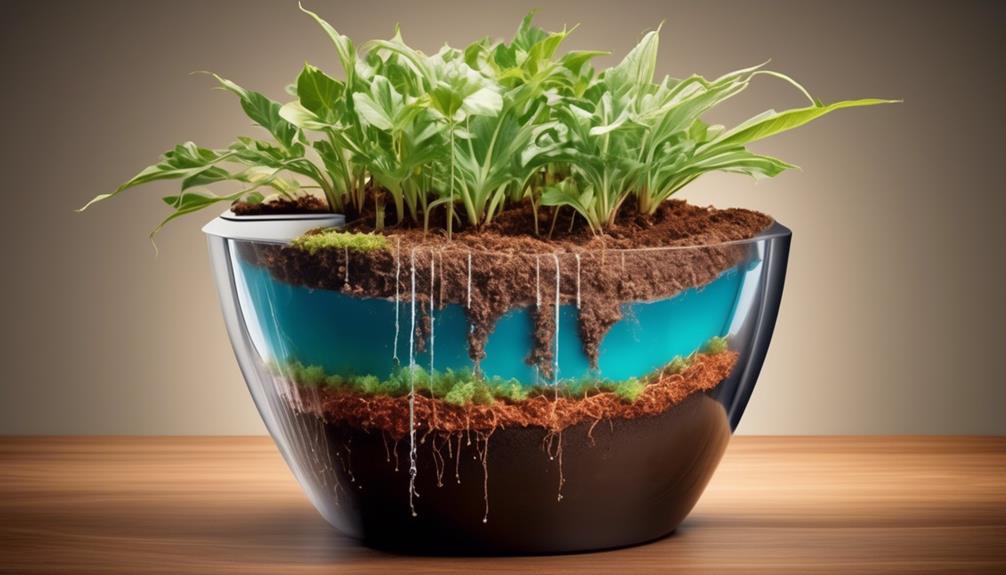
The wicking process in self-watering plant pots is a crucial mechanism for maintaining optimal soil moisture levels.
By utilizing capillary action, the wicking mechanism draws water from the reservoir to the soil, ensuring even distribution throughout the pot.
Understanding the wicking process is essential for effectively regulating water distribution and promoting healthy plant growth.
Wicking Mechanism
Using capillary action, the wicking mechanism in self-watering plant pots draws water from the reservoir to the soil, ensuring consistent moisture for the plant's roots. This process is vital for maintaining optimal soil moisture levels and promoting healthy plant growth. The wicking mechanism's efficiency depends on various factors, including material selection and design.
Here's how it works:
- Capillary Action: The wicking material, typically a porous fabric or rope, allows water to move upwards against gravity, ensuring even distribution to the plant's roots.
- Material Selection: The wicking material must have high absorbency and be resistant to decay to effectively transfer water from the reservoir to the soil.
- Design Considerations: The wicking mechanism's design should optimize contact between the wicking material and the soil to facilitate efficient water transfer.
Understanding the wicking mechanism is crucial for maximizing the effectiveness of self-watering plant pots and promoting successful plant growth.
Water Distribution
Drawing water from the reservoir to the soil, the wicking mechanism in self-watering plant pots ensures consistent moisture levels for the plant's roots, thus facilitating the water distribution process. This process is vital for maintaining optimal plant hydration levels and regulating the watering frequency.
The wicking mechanism utilizes capillary action, where water moves through small spaces in the soil and the wick, ensuring that the plant roots have access to water as needed. As the soil dries out, the wick continues to supply moisture, preventing overwatering or underwatering.
This controlled water distribution not only promotes healthy plant growth but also reduces the risk of root rot and other water-related issues. Understanding the wicking process is crucial for mastering the art of self-watering plant pots and ensuring the overall well-being of your plants.
Oxygenation and Root Health
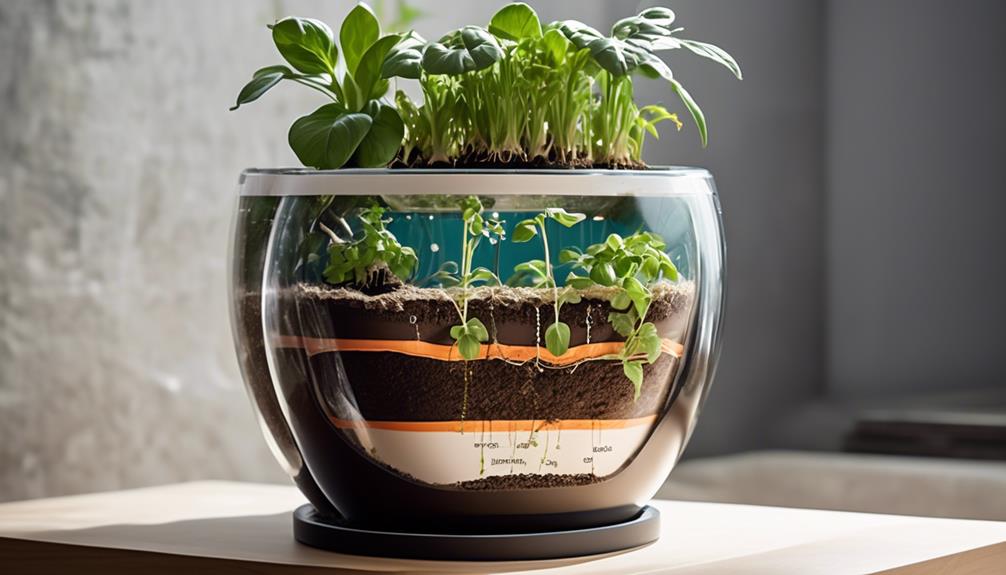
To ensure optimal oxygenation and root health in self-watering plant pots, it's essential to prioritize the balance between moisture retention and aeration within the potting medium. This balance is crucial for promoting the oxygenation process and supporting healthy root development.
Factors Affecting Oxygenation and Root Health in Self-Watering Plant Pots
- Aeration System: The design of the self-watering pot should incorporate an efficient aeration system to facilitate the exchange of gases between the roots and the surrounding environment. This prevents the accumulation of excess moisture around the roots, which can lead to oxygen deprivation.
- Root Zone Moisture Levels: Monitoring and maintaining appropriate moisture levels in the root zone is vital for ensuring root health. Self-watering pots should provide consistent, but not excessive, moisture to prevent waterlogging, which can impede oxygen exchange.
- Potting Medium Composition: The choice of potting medium significantly influences oxygen availability to the roots. A well-aerated, lightweight medium with good water retention properties, such as a mix of peat, perlite, and vermiculite, can promote optimal oxygen levels for root development.
Preventing Overwatering
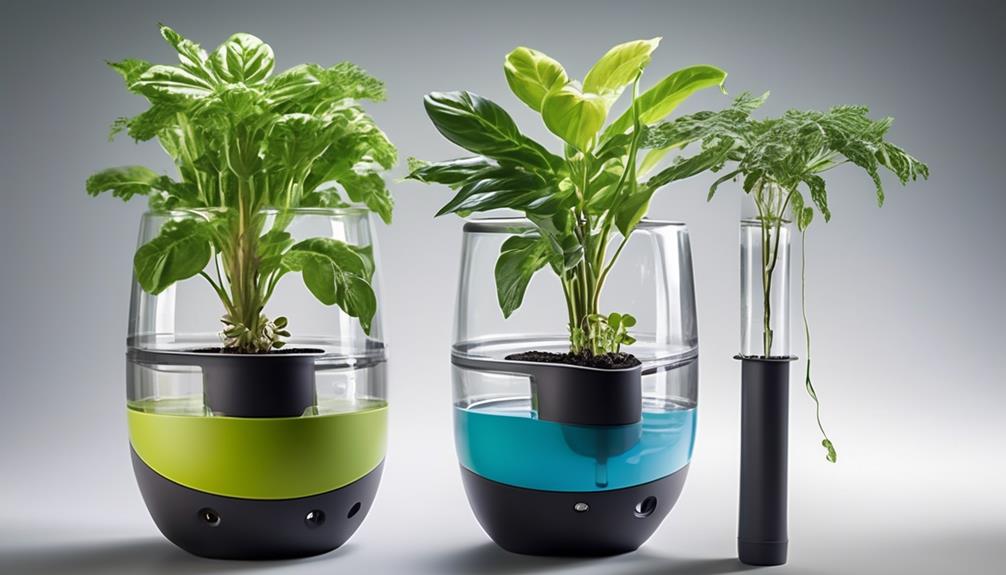
Ensuring proper moisture levels in self-watering plant pots is crucial for preventing overwatering and maintaining healthy root systems. To prevent overwatering, it's important to employ effective moisture control techniques.
One method is to use a potting mix that promotes good drainage, such as a well-aerated, lightweight mix that allows excess water to flow through easily. Additionally, incorporating a layer of coarse material like perlite at the bottom of the pot can further enhance drainage.
Monitoring the moisture levels in the soil is also essential. This can be done by regularly checking the moisture indicator or using a moisture meter to gauge the soil's dampness. Adjusting the watering frequency based on the plant's specific needs and environmental conditions is crucial for preventing overwatering.
It's also beneficial to ensure that the pot has adequate ventilation to prevent waterlogged conditions. By implementing these moisture control techniques, we can effectively prevent overwatering in self-watering plant pots, promoting optimal root health and overall plant vitality.
Understanding Evaporation Control
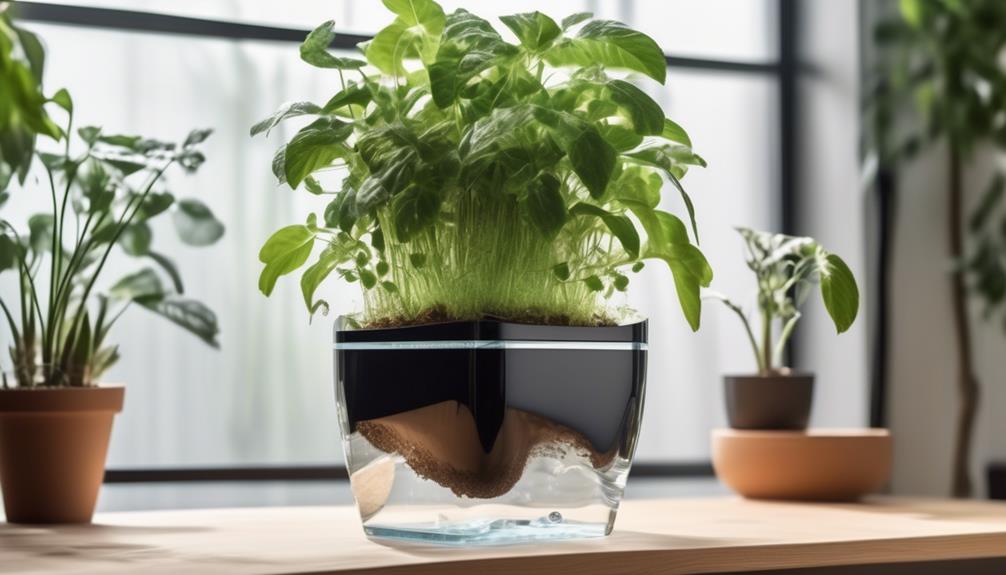
We can control the evaporation rate in self-watering plant pots by using innovative design features.
The water reservoir functions as a crucial element in regulating evaporation.
Understanding the dynamics of evaporation control is essential for maintaining optimal soil moisture levels in self-watering plant pots.
Evaporation Rate Control
Controlling the evaporation rate of water from the soil in self-watering plant pots is essential for maintaining optimal moisture levels for plant growth. Here's how we achieve evaporation rate control:
- Wicking Mechanism: A wicking mechanism draws water from the reservoir into the soil through capillary action, ensuring a steady supply of moisture to the plant roots.
- Aeration and Ventilation: Proper aeration and ventilation in the soil help regulate evaporation by preventing excess moisture buildup and allowing for air exchange, thereby maintaining ideal moisture levels.
- Moisture Barrier: A moisture barrier, such as a plastic sheet or fabric, can be placed between the reservoir and the soil to reduce evaporation, thereby enhancing moisture retention in the soil.
Water Reservoir Function
To understand the function of the water reservoir in self-watering plant pots, it's crucial to consider how it contributes to the control of evaporation rates, which is essential for maintaining optimal moisture levels for plant growth.
The water reservoir serves as a crucial component in water conservation and efficient irrigation. By providing a steady supply of water to the plant's roots, the reservoir minimizes evaporation losses, ensuring that water is used more efficiently. This controlled release of water helps maintain consistent soil moisture, reducing the frequency of manual watering and minimizing water wastage.
Additionally, the reservoir's design prevents excessive water loss due to evaporation, especially in arid conditions, thereby promoting sustainable and responsible water usage.
Understanding the water reservoir's role in evaporation control is vital for maximizing the benefits of self-watering plant pots.
Soil Moisture Regulation
Understanding the mechanism of evaporation control is essential for effectively regulating soil moisture in self-watering plant pots. By comprehending evaporation control, we can optimize the soil moisture levels and ensure precise plant hydration control.
Here are three key aspects to consider:
- Evaporation Rate: Monitoring the rate of evaporation is crucial for adjusting the watering frequency and preventing water loss from the soil.
- Surface Area: Maximizing the contact area between the soil and the pot's reservoir helps in enhancing evaporation control, as a larger surface area facilitates better water absorption.
- Moisture Sealing: Employing moisture-sealing techniques, such as using a cover or mulch, can significantly reduce evaporation from the soil, thus maintaining optimal moisture levels.
Choosing the Right Potting Mix
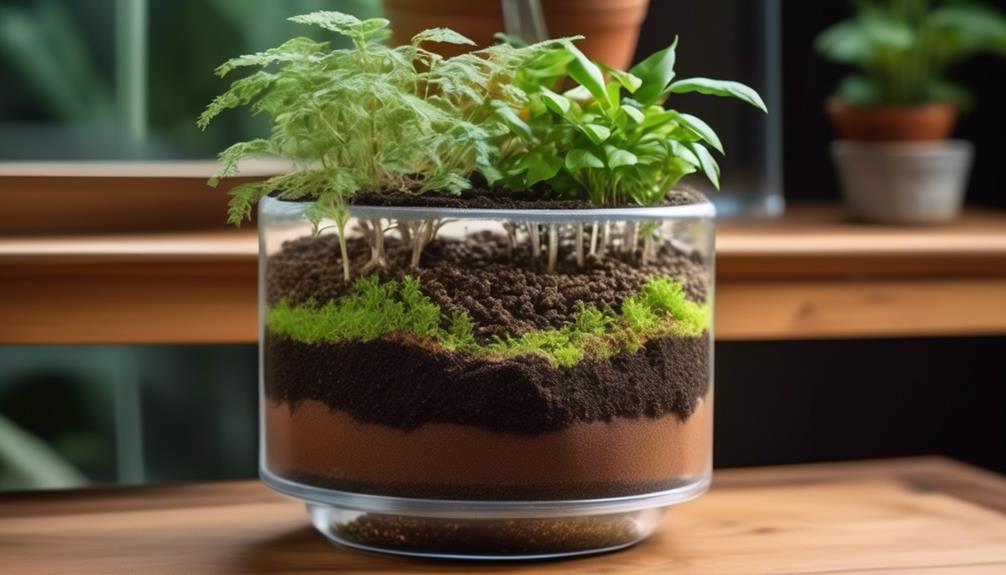
When selecting a potting mix for self-watering plant pots, it's crucial to prioritize components that provide proper aeration and moisture retention. A well-balanced potting mix for self-watering plant pots should be able to retain moisture without becoming waterlogged, while also allowing for adequate aeration to support root health.
To achieve this, it's essential to choose a potting mix that contains materials such as peat moss, coconut coir, or vermiculite, which are known for their water retention capabilities. These components can effectively hold onto moisture, ensuring that the plant roots have access to water as needed.
In addition to water retention, the potting mix should also facilitate nutrient absorption. This can be achieved by incorporating organic matter, such as compost or well-rotted manure, into the mix. These organic materials not only provide essential nutrients for the plants but also contribute to the overall structure of the mix, promoting good drainage and aeration.
When considering potting mixes for self-watering plant pots, it's important to evaluate the specific needs of the plant species being grown and select a mix that aligns with those requirements. By prioritizing proper water retention and nutrient absorption, one can ensure that the chosen potting mix will effectively support the healthy growth of plants in self-watering pots.
Maintenance and Refilling Tips
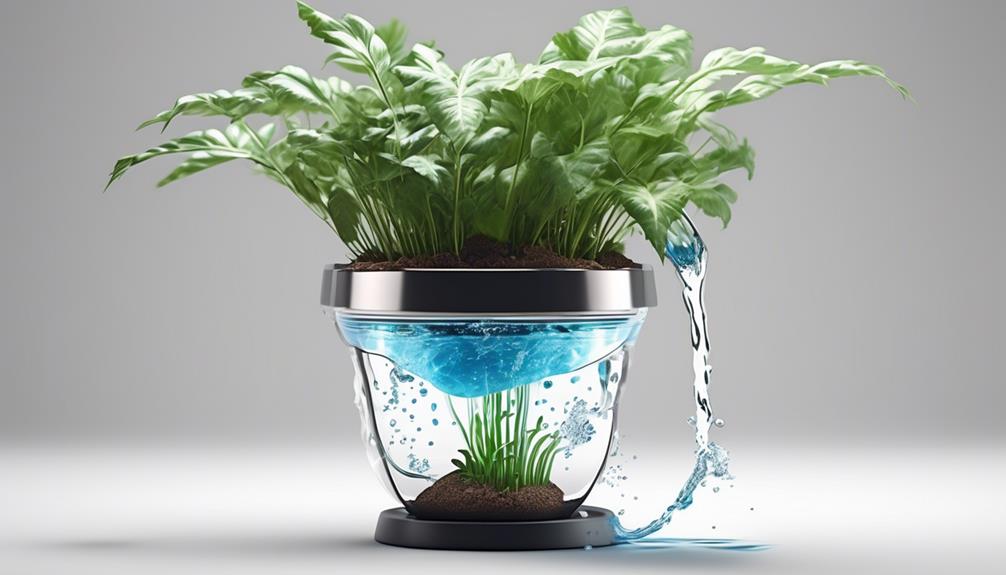
In maintaining self-watering plant pots, ensuring proper aeration and moisture retention in the potting mix is crucial for the long-term health of the plants. Regular maintenance and refilling are essential for the effective functioning of self-watering pots. Here are some key tips to ensure optimal performance:
- Refilling frequency: Check the water reservoir regularly to monitor the water level. Refill the reservoir when it's nearly empty, typically every 1-2 weeks, depending on the plant's water requirements and environmental conditions. This will help maintain consistent moisture levels in the potting mix.
- Moisture level monitoring: Use a soil moisture meter to assess the moisture content in the potting mix. This will prevent overwatering, a common issue with self-watering pots. Ensure that the potting mix is moist but not waterlogged to avoid root rot and other water-related problems.
- Cleaning and maintenance: Periodically clean the reservoir and the pot to prevent the buildup of algae, mineral deposits, or mold. This will help maintain a healthy environment for the plant's roots and ensure the efficient self-watering system.
Benefits for Different Plant Types
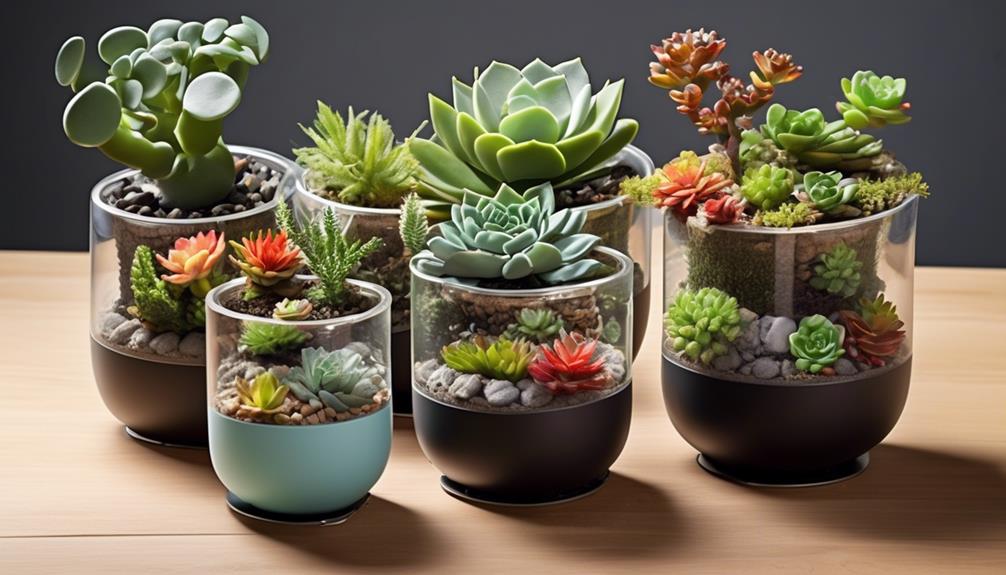
Different plant types benefit from self-watering pots due to their ability to provide consistent moisture levels tailored to the specific needs of each plant, promoting healthy growth and reducing the risk of overwatering or underwatering.
This system is particularly advantageous for plants that have adapted to specific environmental conditions. For instance, succulents, which naturally thrive in arid environments, require infrequent watering. Self-watering pots can mimic these conditions by providing gradual and sparing moisture, preventing root rot and ensuring the plant's survival.
On the other hand, plants such as ferns, which flourish in humid environments, can benefit from a self-watering pot's ability to maintain higher moisture levels. This promotes optimal growth without the risk of waterlogging the soil.
Additionally, self-watering pots contribute to water conservation by minimizing wastage through evaporation or excess runoff. By delivering water directly to the plant's roots as needed, these pots ensure efficient water usage, making them an environmentally friendly choice for plant care.
Environmental and Sustainability Impact

To gauge the environmental and sustainability impact of self-watering plant pots, it's essential to assess their water usage efficiency and long-term contribution to conservation efforts.
- Resource conservation and water efficiency: Self-watering plant pots are designed to deliver water directly to the plant's roots, minimizing water waste through evaporation or runoff. This targeted watering system optimizes water usage, promoting conservation efforts and reducing overall water consumption in plant care.
- Impact on plant growth and nutrient retention: These pots provide consistent moisture levels, supporting healthy plant growth and reducing the risk of overwatering or underwatering. Additionally, the self-contained reservoirs help retain essential nutrients within the soil, promoting efficient nutrient uptake by the plants. This not only benefits the plants but also contributes to sustainable gardening practices by minimizing the need for additional fertilization.
- Long-term sustainability: By promoting water conservation and optimizing plant health, self-watering plant pots contribute to sustainable gardening practices. Their efficient use of resources and support for healthy plant growth align with environmentally friendly principles, making them a valuable tool for long-term environmental impact and sustainability.
Frequently Asked Questions
Are Self-Watering Pots Suitable for All Types of Plants, Including Succulents and Cacti?
Self-watering pots can be suitable for many types of plants, including succulents and cacti. When it comes to succulent care, these pots provide consistent moisture levels and can help prevent overwatering.
For cacti, which have lower moisture requirements, self-watering pots can be used cautiously to avoid excessive moisture. Understanding the individual watering needs of specific plants is essential when using self-watering pots to ensure optimal growth and health.
Can Self-Watering Pots Be Used Outdoors, or Are They Only Suitable for Indoor Use?
Absolutely, self-watering pots can be used outdoors, providing a convenient and efficient watering solution for your outdoor plants.
The key is to adjust the watering schedule based on the specific needs of your outdoor plants and the local climate. By carefully monitoring the moisture levels and adjusting the watering mechanism, self-watering pots can effectively support the health and growth of your outdoor plants while minimizing the need for frequent manual watering.
How Often Do Self-Watering Pots Need to Be Refilled With Water?
We typically refill our self-watering pots every 1-2 weeks, but this can vary based on factors like evaporation rates, plant hydration needs, and soil moisture levels.
Many self-watering pots have water level indicators to help gauge when a refill is necessary. The watering technology in these pots allows for a consistent supply of water to the plants, maintaining optimal soil moisture.
Do Self-Watering Pots Require Any Special Maintenance or Cleaning to Prevent Mold or Algae Growth?
Regular maintenance is crucial for preventing mold and algae growth in self-watering pots. We've found that a weekly cleaning routine using mild detergent and water helps keep the pot's reservoir free from buildup.
Additionally, it's important to regularly inspect the pot's wicking system for any clogs or blockages. By staying on top of these tasks, we've been able to maintain a healthy environment for our plants without any issues.
Can Self-Watering Pots Be Used in Conjunction With a Drip Irrigation System for Larger Plant Setups?
Yes, self-watering pots can be used with a drip irrigation system for larger plant setups. This compatibility optimizes plant growth by ensuring consistent moisture levels.
The benefits of self-watering pots, such as minimizing water waste and reducing the frequency of manual watering, are enhanced when combined with a drip irrigation system.
This integration provides an efficient and effective solution for maintaining plant health and vitality in larger setups.
What is the Mechanism Behind Self-Watering Plant Pots and Containers?
Self-watering plant containers use a wicking system to draw water from a reservoir into the soil, providing consistent moisture levels for the plant. This mechanism helps to prevent over-watering and ensures that the plant has access to water as needed for optimal growth and health.
Conclusion
In conclusion, the self-watering plant pot works through the capillary action mechanism, water reservoir function, soil moisture regulation, and wicking process.
This innovative system benefits a wide range of plant types and promotes environmental sustainability.
By choosing the right potting mix and following maintenance and refilling tips, the self-watering pot provides a practical and efficient solution for watering plants.

